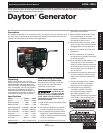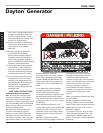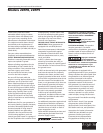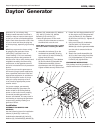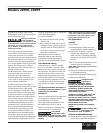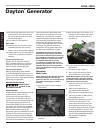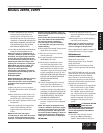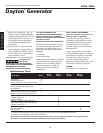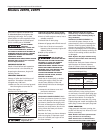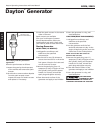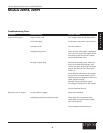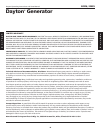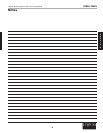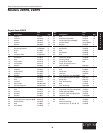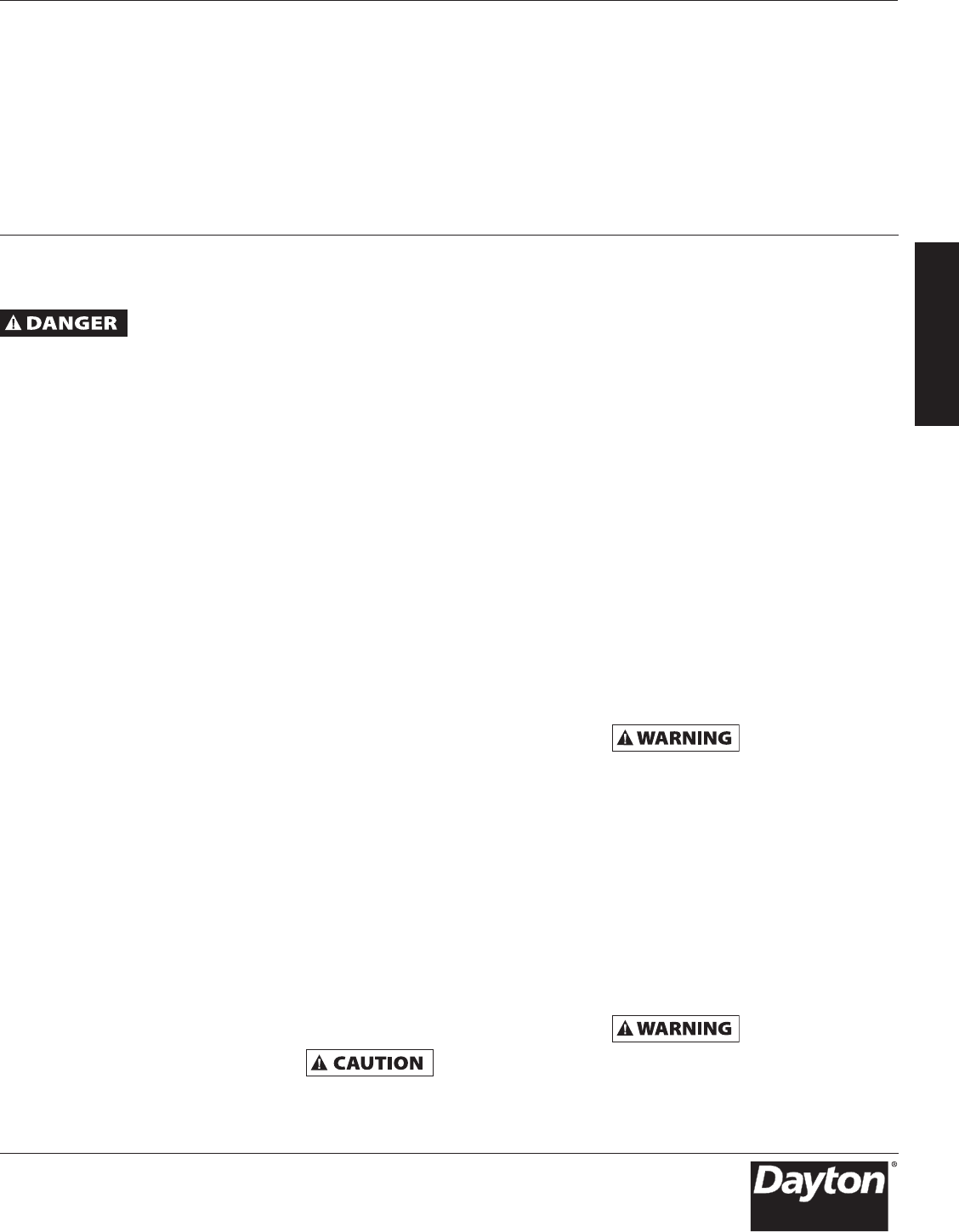
5
E
N
G
L
I
S
H
Models 2ZRP8, 2ZRP9
Dayton Operating Instructions and Parts Manual
grounding provides a path of least
resistance for electric current to reduce
the risk of electric shock.
Improper connection
of the equipment-
grounding conductor can result in a risk
of electrocution. Check with a qualified
electrician or service person if you
are in doubt as to whether the unit is
properly grounded.
The wing nut and ground terminal
on the frame must always be used to
connect the generator to a suitable
ground source. The ground path should
be made with #8 size wire. Connect the
terminal of the ground wire between
the two star washers and wing nut then
tighten the wing nut fully. Connect
the other end of the wire securely to a
suitable ground source.
The National Electric Code contains
several practical ways in which to
establish a good ground source.
Examples given below illustrate a few
of the ways in which a good ground
source may be established.
A metal underground water pipe in
direct contact with the earth for at least
10 feet can be used as a grounding
source. If an pipe is unavailable, an 8
foot length of pipe or rod may be used
as the ground source. The pipe should
be 3/4 inch trade size or larger and the
outer surface must be noncorrosive.
If a steel or iron rod is used it should
be at least 5/8 inch diameter and if a
nonferrous rod is used it should be at
least 1/2 inch diameter and be listed
as material for grounding. Drive the
rod or pipe to a depth of 8 feet. If a
rock bottom is encountered less than
4 feet down, bury the rod or pipe in a
trench. All electrical tools and appliances
operated from this generator, must be
properly grounded by use of a third wire
or be “Double Insulated”.
It is recommended to:
1. Use electrical devices with 3 prong
power cords.
2. Use an extension cord with a 3 hole
receptacle and a 3 prong plug at the
opposite ends to ensure continuity
of the ground protection from the
generator to appliance.
We strongly recommend that all
applicable federal, state and local
regulations relating to grounding
specifications be checked and followed.
LINE TRANSFER SWITCH
If this generator is used for standby
service, it must have a transfer switch
between the utility power service and
the generator. The transfer switch not
only prevents the utility power form
feeding into the generator, but is also
prevents the generator form feeding
out into the utility company’s lines. This
is intended to protect the serviceman
who may be working on a damaged
line.
THIS INSTALLATION MUST BE DONE BY A
LICENSED ELECTRICIAN AND ALL LOCAL
CODES MUST BE FOLLOWED.
ENGINE OIL
Use oil viscosity based on the expected
air temperature range during the
period between oil changes.
Use a high quality detergent oil with
API classifications of SJ or higher.
Check oil level before each operation
and ensure that it is maintained.
THIS ENGINE
CRANKCASE IS NOT
FILLED WITH OIL AT THE FACTORY, SO BE
SURE TO FILL IT BEFORE OPERATING THE
ENGINE.
NOTE: These engines are equipped with
a “Low Oil” shut-off system for engine
protection. If the engine fails to start,
check engine crankcase for oil.
Pre-Operation
FUELING
To fill with oil:
1. Level the engine to ensure accurate
inspection and to prevent overfilling.
2. Unscrew the oil gauge, wipe the
dipstick dry. Reinsert the oil gauge
back into the oil fill gauge opening.
Remove the oil gauge and check the
oil level.
3. The oil level should be between the full
and low marks on the dipstick.
NOTE: When checking the oil be sure the
engine is level.
4. Fill with oil as required through the
oil fill gauge opening.
5. Replace the oil gauge and screw in firmly.
6. Wipe up any spilled oil.
EXPLOSIVE FUEL!
GASOLINE IS
EXTREMELY FLAMMABLE AND ITS
VAPORS CAN EXPLODE IF IGNITED.
STORE GASOLINE ONLY IN APPROVED
CONTAINERS, IN WELL VENTILATED,
UNOCCUPIED BUILDINGS AND AWAY
FROM SPARKS OR FLAMES.
DO NOT FILL THE FUEL TANK WHILE THE
ENGINE IS HOT OR RUNNING, SINCE
SPILLED FUEL COULD IGNITE IF IT COMES
IN CONTACT WITH HOT PARTS OR SPARKS
FROM IGNITION. DO NOT START THE
ENGINE NEAR SPILLED FUEL.
NEVER USE GASOLINE AS A CLEANING
AGENT.
DO NOT OVERFILL THE
FUEL TANK, LEAVE
ROOM FOR THE FUEL TO EXPAND.
GENERAL RECOMMENDATIONS
• Purchase gasoline in small quantities and
store in clean, approved containers.



